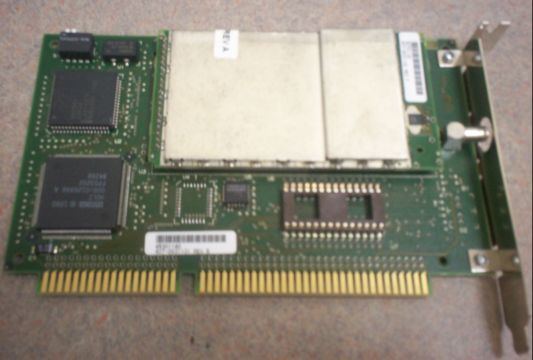 | ||
WaveLAN was a brand name for a family of wireless networking technology sold by NCR, AT&T, and Lucent, as well as being sold by other companies under OEM agreements. The WaveLAN name debuted on the market in 1988 and was in use into the mid-1990s, when Lucent renamed their products to ORiNOCO.
Contents
- History
- Specifications
- Hardware
- Security
- Officially released drivers
- Volunteer developed drivers
- Examples
- 915 MHz
- 24 GHz
- Options
- References
WaveLAN has been used on two different families of wireless technology:
History
WaveLAN was originally designed by COMTEN, a subsidiary of NCR Corporation, (later the Network Products Division of NCR) in 1986-7, and introduced to the market in 1988 as a wireless alternative to Ethernet and Token-Ring. The next year NCR contributed the WaveLAN design to the IEEE 802 LAN/MAN Standards Committee. This led to the founding of the 802.11 Wireless LAN Working Committee which produced the original IEEE 802.11 standard, which eventually became known popularly as Wi-Fi. When NCR was acquired by AT&T in 1991, becoming the AT&T GIS (Global Information Solutions) business unit, the product name was retained, as happened two years later when the product was transferred to the AT&T GBCS (Global Business Communications Systems) business unit, and again when AT&T spun off their GBCS business unit as Lucent in 1995. The technology was also sold as WaveLAN under an OEM agreement by Epson, Hitachi,and NEC, and as the RoamAbout DS by DEC. It competed directly with Aironet's non-802.11 ARLAN lineup, which offered similar speeds, frequency ranges and hardware.
Several companies also marketed wireless bridges and routers based on the WaveLAN ISA and PC cards, like the C-Spec OverLAN, KarlNet KarlBridge, Persoft Intersect Remote Bridge, and Solectek AIRLAN/Bridge Plus. Lucent's WavePoint II access point could accommodate both the classic WaveLAN PC cards as well as the WaveLAN IEEE cards. Also, there were a number of compatible third-party products available to address niche markets such as: Digital Ocean's Grouper, Manta, and Starfish offerings for the Apple Newton and Macintosh; Solectek's 915 MHz WaveLAN parallel port adapter; Microplex's M204 WaveLAN-compatible wireless print server; NEC's Japanese-market only C&C-Net 2.4 GHz adapter for the NEC-bus; Toshiba's Japanese-market only WaveCOM 2.4 GHz adapter for the Toshiba-Bus; and Teklogix's WaveLAN-compatible Pen-based and Notebook terminals.
During this time frame, networking professionals also realized that since NetWare 3.x and 4.x supported the WaveLAN cards and came with a Multi Protocol Router module that supported the IP/IPX RIP and OSPF routing protocols, one could construct a wireless routed network using NetWare servers and WaveLAN cards for a fraction of the cost of building a wireless bridged network using WaveLAN access points. Many NetWare classes and textbooks of the time included a NetWare OS CD with a 2-person license, so potentially the only cost incurred came from hardware.
When the 802.11 procotol was ratified, Lucent began producing chipsets to support this new standard under the name of WaveLAN IEEE, which it later renamed to ORiNOCO. Shortly thereafter, Lucent spun off the division that produced these chipsets as Agere Systems, which was later acquired by Proxim. Proxim later renamed its entire 802.11 wireless networking lineup to ORiNOCO, including products based on Atheros chipsets.
Specifications
Classic WaveLAN operates in the 900 MHz or 2.4 GHz ISM bands. Being a proprietary pre-802.11 protocol, it is completely incompatible with the 802.11 standard.
Hardware
The ISA and MCA cards were based on the Intel 82586 Ethernet PHY controller, which was a commonly used controller in its time and was found in many ISA and MCA Ethernet cards, such as the Intel EtherExpress 16 and the 3COM 3C523. The PCMCIA cards used the Intel 82593 PHY controller. The radio modem section was hidden from the OS, thus making the WaveLAN card appear to be a typical Ethernet card, with the radio-specific features taken care of behind the scenes.
While the 900 MHz models and the early 2.4 GHz models operated on one fixed frequency, the later 2.4 GHz cards as well as some 2.4 GHz WavePoint access points had the hardware capacity to operate over ten channels, ranging from 2.412 GHz to 2.484 GHz, with the channels available being determined by the region-specific firmware.
Security
For security, WaveLAN used a 16-bit NWID (NetWork ID) field, which yielded 65,536 potential combinations; the radio portion of the device could receive radio traffic tagged with another NWID, but the controller would discard the traffic. DES encryption (56-bit) was an option in some of the ISA and MCA cards and all of the WavePoint access points. The full-length ISA and MCA cards had a socket for an encryption chip, the half-length 915 MHz ISA cards had solder pads for a socket which was never added, and the 2.4 GHz half-length ISA cards had the chip soldered directly to the board.
There are two large holes in the WaveLAN security strategy, though:
Officially released drivers
Volunteer-developed drivers
Linux has included support for ISA Classic WaveLAN cards since the 2.0.37 kernel, while full support for the PC card Classic WaveLAN cards came later. Status of support for MCA Classic Wavelan cards is unknown.
FreeBSD version 2.2.1-up and the Mach4 kernel have had native support for the ISA Classic WaveLAN cards for several years. OpenBSD and NetBSD do not natively support any of the Classic WaveLAN cards.
Several open-source projects, such as NdisWrapper and Project Evil, currently exist that allow the use of NDIS drivers via a "wrapper". This allows non-Windows OS' to utilize the near-universal nature of drivers written for the Windows platform to the benefit of other operating systems, such as Linux, FreeBSD, and ZETA.
Examples
Classic WaveLAN technology was available for the MCA, ISA/EISA, and PCMCIA interfaces:
